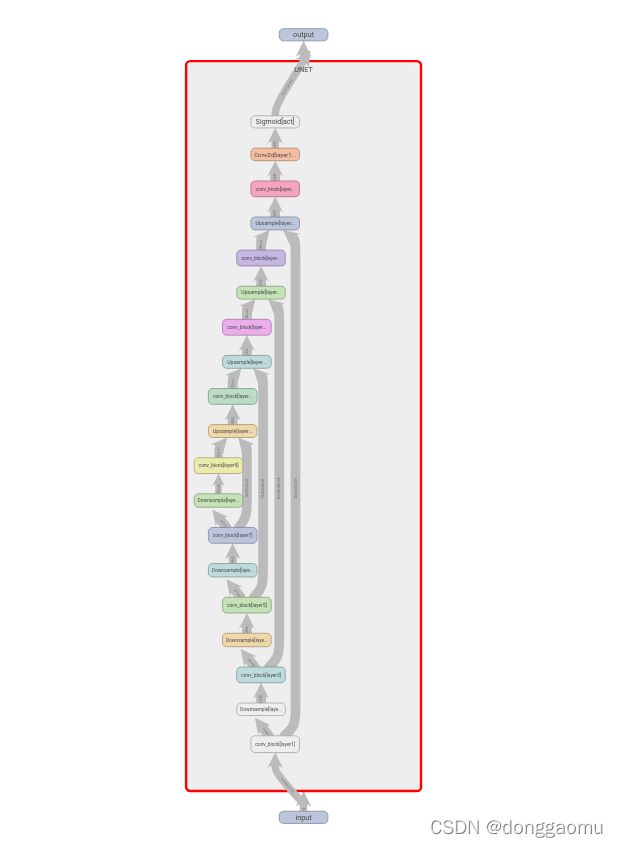Unet网络搭建(Pytorch)
Unet是一个经典的语义分割网络,常常被用于医学影像的分割。在Unet的网络结构中,可以分为卷积模块,下采样模块以及上采样模块,详见下面的网络结构图:
 在网络的搭建过程中,也是依照分为三大块这种思路进行搭建。话不多说,直接上代码:
在网络的搭建过程中,也是依照分为三大块这种思路进行搭建。话不多说,直接上代码:
import torch
import torch.nn as nn
import torch.nn.functional as F
from torch.utils.tensorboard import SummaryWriter
class conv_block(nn.Module):
def __init__(self,in_c,out_c):
super(conv_block,self).__init__()
self.layer1 = nn.Sequential(
nn.Conv2d(in_c,out_c,kernel_size=(3,3),stride=1,padding=1,padding_mode='reflect'),
nn.BatchNorm2d(out_c),
nn.Dropout(0.3),
nn.ReLU(inplace=True),
)
self.layer2 = nn.Sequential(
nn.Conv2d(out_c, out_c, kernel_size=(3, 3), stride=1, padding=1, padding_mode='reflect',bias = False),
nn.BatchNorm2d(out_c),
nn.Dropout(0.3),
nn.ReLU(inplace=True),
)
def forward(self,x):
x = self.layer1(x)
x = self.layer2(x)
return x
class Downsample(nn.Module):
def __init__(self,channel):
super(Downsample, self).__init__()
self.layer = nn.Sequential(
nn.Conv2d(channel, channel, kernel_size=(3, 3), stride=2, padding=1, bias=False),
nn.BatchNorm2d(channel),
nn.ReLU()
)
def forward(self,x):
return self.layer(x)
class Upsample(nn.Module):
def __init__(self,channel):
super(Upsample, self).__init__()
self.conv1 = nn.Conv2d(channel,channel//2,kernel_size=(1,1),stride=1)
def forward(self,x,featuremap):
x = F.interpolate(x,scale_factor=2,mode='nearest')
x = self.conv1(x)
x = torch.cat((x,featuremap),dim=1)
return x
class UNET(nn.Module):
def __init__(self,in_channel,out_channel):
super(UNET, self).__init__()
self.layer1 = conv_block(in_channel,out_channel)
self.layer2 = Downsample(out_channel)
self.layer3 = conv_block(out_channel,out_channel*2)
self.layer4 = Downsample(out_channel*2)
self.layer5 = conv_block(out_channel*2,out_channel*4)
self.layer6 = Downsample(out_channel*4)
self.layer7 = conv_block(out_channel*4,out_channel*8)
self.layer8 = Downsample(out_channel*8)
self.layer9 = conv_block(out_channel*8,out_channel*16)
self.layer10 = Upsample(out_channel*16)
self.layer11 = conv_block(out_channel*16,out_channel*8)
self.layer12 = Upsample(out_channel*8)
self.layer13 = conv_block(out_channel*8,out_channel*4)
self.layer14 = Upsample(out_channel*4)
self.layer15 = conv_block(out_channel*4,out_channel*2)
self.layer16 = Upsample(out_channel*2)
self.layer17 = conv_block(out_channel*2,out_channel)
self.layer18 = nn.Conv2d(out_channel,3,kernel_size=(1,1),stride=1)
self.act = nn.Sigmoid()
def forward(self,x):
x = self.layer1(x)
f1 = x
x = self.layer2(x)
x = self.layer3(x)
f2 = x
x = self.layer4(x)
x = self.layer5(x)
f3 = x
x = self.layer6(x)
x = self.layer7(x)
f4 = x
x = self.layer8(x)
x = self.layer9(x)
x = self.layer10(x,f4)
x = self.layer11(x)
x = self.layer12(x,f3)
x = self.layer13(x)
x = self.layer14(x,f2)
x = self.layer15(x)
x = self.layer16(x,f1)
x = self.layer17(x)
x = self.layer18(x)
return self.act(x)
if __name__ == '__main__':
#device = 'cuda' if torch.cuda.is_available() else 'cpu'
x = torch.randn(10,3,256,256)
model = UNET(3,64)
#if hasattr(torch.cuda, 'empty_cache'):
#torch.cuda.empty_cache()
x = model(x)
print(x.size())
wiriter = SummaryWriter('log1')
wiriter.add_graph(model,x)
